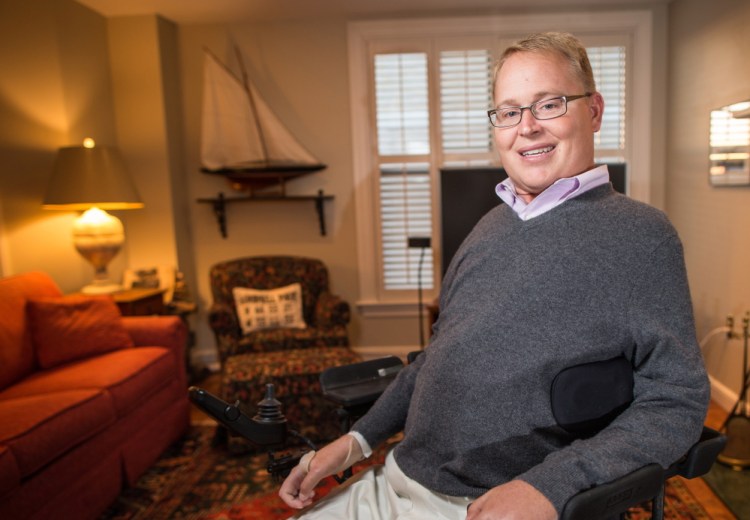Back when he raced up and down Maine’s frozen rinks, Travis Roy could perform magic with a hockey puck, flicking it past goaltenders before they had a chance to react.
Now, even though more than 19 years have passed since his last hockey game, Roy has developed another nifty trick.
He can make a wheelchair disappear.
See for yourself Thursday night at the Marriott Sable Oaks in South Portland, where Roy will be honored at the 10th annual dinner and auction to benefit The Cromwell Center for Disabilities Awareness.
Roy likes to say that the first 20 years of his life were filled with passion, right up until his first shift for Boston University, when he fell headfirst into the corner boards, and cracked the fourth and fifth vertebrae in his neck. Paralyzed since that moment in 1995, Roy has regained some movement in his right arm, enough to push the joystick on his motorized wheelchair.
The succeeding 19 years and seven months “have been filled with purpose,” said Roy, who turned 40 in April. “That’s just as special, just not quite as much fun.”
Much of Roy’s purpose dovetails with that of The Cromwell Center, whose recent honorees include Boston Marathon athletes Rick and Dick Hoyt, and former Red Sox outfielder Dwight Evans, who has sons with neurofibromatosis. The goal is to change attitudes – particularly those of children – who come in contact with people who live with disabilities, both visible and invisible.
“We’re trying to help kids understand that disability is just one aspect of what makes people different from one another,” said Susan Greenwood, executive director of the center that has worked with more than 10,000 elementary school students throughout southern Maine. “We work with the kids in smaller groups, in individual classrooms. This is not an information session or a show-and-tell assembly. It’s really getting kids to think about preconceptions, about kindness, about anti-bullying.”
Roy also speaks often to school groups. When he wheels himself into a new school, he knows the students are a bit skittish, not sure what to expect from the man with upright posture, thinning blond hair and a wide smile.
“They’re all a little nervous about my wheelchair,” he said, “and about the wrist brace on my arm.”
Then Roy tells them about his experiences with hockey, with his injury, and with his life since the accident. He talks about struggling in the classroom with a mild form of dyslexia, trying like heck to earn the same grades as his peers but knowing he’d have to work twice as hard in order to do so.
He also speaks of his own ignorance and uncertainty in communicating with students who had intellectual, developmental or physical disabilities.
“I was an able-bodied, strong athlete and I wasn’t great about dealing with people with disabilities,” he admits. “I’ve learned how important it is to engage. It’s not as complicated as people think it is. Just a smile and a warm hello (from others) went a long way to my thinking there was more to me than this wheelchair.”
The kids ask questions. Roy responds. They might talk hockey. He’s been following the Stanley Cup playoffs and watched his beloved BU compete in the NCAA Frozen Four in April. He said nothing compares to a Game 7 or overtime in the playoffs.
They might talk disabilities. Nearly every school has a few kids with obvious disabilities. Roy will talk about returning to his dormitory at BU after his injury, about avoiding eye contact as he tried to figure out who he was, about how, in the midst of a crowded, boisterous cafeteria, he would eat alone because no one dared to sit at his table.
“It was hard and it was heartbreaking,” he said. “My sophomore year, I knew I had to be more open so I started looking people in the eye, I put a smile on my face, and I would say hello. That would start to break down some of those barriers.”
Before long the barriers between Roy and his audience evaporate, and students start viewing their classmates in an entirely new way. Maybe some will feel more included, less ostracized. That’s Roy’s goal. That’s the Center’s goal.
Life changed abruptly on that October evening nearly two decades ago, but for Travis Roy it did not end.
“When I leave that room, it’s almost like the wheelchair has disappeared and they see me and they realize there’s a lot more to me than the wheelchair,” he said. “Every time I’m in a school, I see that change, and it feels good to be a part of that, to open up their eyes and to help them be a bit more worldly and to not be so intimidated by someone with a disability.”
The stick changed from hockey to joy. The magician has changed as well, but his tricks continue to impress.
Send questions/comments to the editors.




Success. Please wait for the page to reload. If the page does not reload within 5 seconds, please refresh the page.
Enter your email and password to access comments.
Hi, to comment on stories you must . This profile is in addition to your subscription and website login.
Already have a commenting profile? .
Invalid username/password.
Please check your email to confirm and complete your registration.
Only subscribers are eligible to post comments. Please subscribe or login first for digital access. Here’s why.
Use the form below to reset your password. When you've submitted your account email, we will send an email with a reset code.